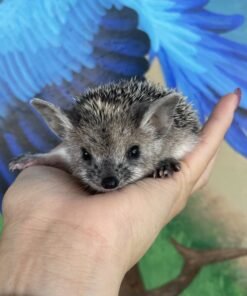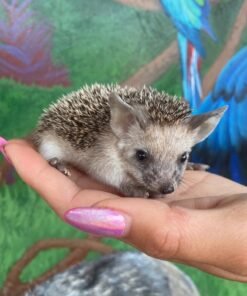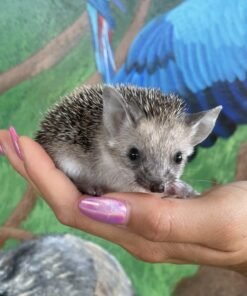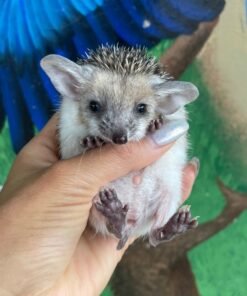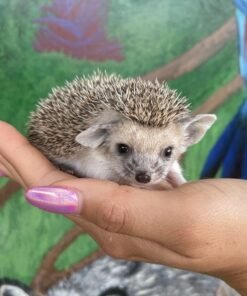Hedgehog
Hedgehogs: Detailed Overview
Scientific Classification:
- Order: Erinaceomorpha
- Family: Erinaceidae
- Genus: Erinaceus (common European hedgehog)
General Description
Hedgehogs are small, spiny mammals known for their distinctive appearance and behavior. They have a widespread distribution, found in Europe, Asia, and Africa. They are primarily nocturnal and have adapted well to various environments. Hedgehog
Physical Characteristics
- Size and Appearance
- Weight: Typically ranges from 400 grams to 1.2 kilograms (0.88 to 2.64 pounds).
- Length: 14 to 30 cm (5.5 to 11.8 inches).
- Color: Spines are usually brown with white tips, while their fur can range from brown to white.
- Spines
- Hedgehogs are covered in spines (modified hairs), which provide protection from predators.
- When threatened, they can roll into a tight ball, presenting only their spines to potential predators.
- Face and Limbs
- They have a pointed snout, small eyes, and small, rounded ears.
- Their limbs are short, with five toes on each foot.
Behavior and Lifestyle
- Activity Patterns
- Nocturnal: Active primarily at night, foraging for food and exploring their environment. FEMALE HEDGEHOG FOR SALE
- During the day, they rest in nests made of leaves, grass, and other vegetation.
- Diet
- Insectivorous: Diet mainly consists of insects, worms, snails, and other invertebrates.
- They may also consume small vertebrates, fruits, and vegetables.
- Communication
- Communicate through a variety of sounds such as grunts, snuffles, and squeals.
- Use body language and scent marking for communication and territory marking. MALE HEDGEHOG
Habitat
- Range
- Found in diverse habitats including forests, grasslands, deserts, and suburban areas.
- Adaptable to various environments as long as there is adequate food and shelter.
- Nesting
- Construct nests from leaves, grass, and other natural materials.
- Often found under hedgerows, logs, or bushes in gardens and woodlands.
Reproduction
- Breeding Season
- Typically breed once or twice a year, depending on the species and location. MALE HEDGEHOG FOR SALE
- In temperate regions, breeding usually occurs in spring and summer.
- Gestation and Birth
- Gestation Period: About 35 to 58 days.
- Litter Size: Usually 4 to 7 young, called hoglets.
- Hoglets are born blind and with soft spines, which harden a few hours after birth.
- Parental Care
- Female hedgehogs take sole responsibility for caring for the young.
- Hoglets are weaned at about 4 to 6 weeks old and become independent shortly after.
Adaptations
- Defense Mechanism
- Ability to roll into a tight ball, with spines pointing outward to deter predators. FEMALE HEDGEHOG
- Hibernation
- In colder climates, some species hibernate during the winter months.
- They enter a state of torpor, lowering their metabolic rate to conserve energy.
- Sensory Adaptations
- Keen sense of smell and hearing to locate food and detect predators.
- Limited vision, relying more on other senses.
Conservation Status
- Threats
- Habitat loss, road mortality, and pesticide use.
- Predation by domestic animals like dogs and cats.
- Conservation Efforts
- Creating and preserving hedgehog-friendly habitats.
- Public awareness campaigns to reduce road deaths and promote safe gardening practices.
Interesting Facts
- Ancient History
- Hedgehogs have existed for millions of years, with little change in their basic form.
- Pets
- Some species, like the African pygmy hedgehog, are kept as pets.
- Require specialized care and diet to thrive in captivity.
- Ecosystem Role
- Play a crucial role in controlling insect populations.
- Their foraging habits help aerate the soil and promote healthy plant growth.
Conclusion
Hedgehogs are fascinating and resilient creatures with a unique set of adaptations that have enabled them to survive in various environments. Their nocturnal habits, diet, BUY FEMALE HEDGEHOG, and defense mechanisms make them a vital part of many ecosystems. Conservation efforts are essential to protect these charming animals from the threats they face in the modern world. Understanding their behavior, habitat needs, and ecological importance can help ensure their survival for future generations. BUY MALE HEDGEHOG


